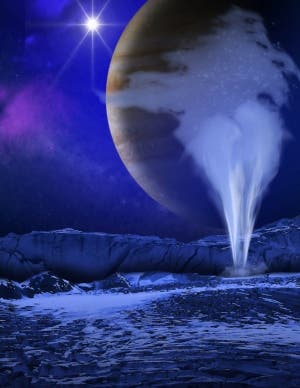Europa, Jupiter’s satellite, has emerged as one of the top locations in the Solar System in terms of its potential of hosting extraterrestrial life. Despite the fact that it lies so far from the Sun, scientists believe that a liquid ocean lies under its icy surface – and that ocean could very well host life.

The plumes detected on Europa by the Hubble Space Telescope may be 200 kilometres tall, as depicted in this artist’s impression.
Now, Europa just got a lot more interesting for that purpose: astronomers spotted possible plumes of water spraying from its South Pole.
The jets resemble an icy geyser, very similar to those already observed on Saturn’s moon Enceladus. However, plumes on Enceladus are even more interesting because they have such a good chance of tapping into a watery environment that hosts life.
“If this pans out, it’s potentially the biggest news in the outer Solar System since the discovery of the Enceladus plume,” says Robert Pappalardo, a planetary scientist at the Jet Propulsion Laboratory in Pasadena, California, who was not involved in the research.
Astronomers have suspected that plumes like this existed on Europa for quite some time. The theoretical work seemed to suggest it, but observations just couldn’t find it – until now.
“It’s a first-time discovery, and we need to go back and look some more,” says team member Joachim Saur, a planetary scientist at the University of Cologne in Germany.
Saur and his teammates first tried to find these plumes several times, to no avail. But in 2012, they tried again, once in November, and once in December. The November survey came up empty, but just as they were about to give up hope, they found something in December: blobs of hydrogen and oxygen near Europa’s South Pole. They found this not through chance, but by focusing more on when they looked at it. They scheduled the observation for then the satellite is farthest away from its planet, when changes in the tidal forces cause additional stress in the icy crust. This could explain why other researchers haven’t been able to observe the plumes, and it also gives a very good starting point for future observations.
The plumes are approximately 200 km high – This is many times the height suggested by most theoretical research. The plumes may or may not reach deep into the liquid ocean – the heat generated by the friction of ice rubbing against itself might melt parts of the icy crust and feed the plumes. Either way, this is another thing to focus on for the 2022 European Space Agency mission which is set for Europa.






